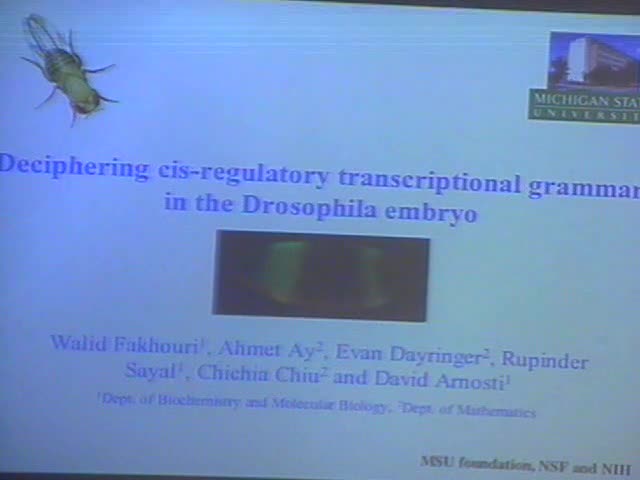A "Bottom-up" Approach to Deciphering and Predicting Cis-regulatory Transcriptional Grammar in Drosophila
Presenter
March 4, 2008
Keywords:
- Transcriptional Grammar
MSC:
- 68Q42
Abstract
Joint work with
Ahmet Ay2, Evan Dayringer2, Rupinder Sayal1, Chichia Chiu2, David N. Arnosti1.
Cis regulatory information comprises a key portion of genetic coding,
yet despite the abundance of genomic sequences now available,
identifying and characterizing this information remains a major
challenge. We are pursuing a unique “bottom-up” approach to understand
the mechanistic processing of the regulatory elements (input codes) by
the transcriptional machinery, using a well-defined and characterized
set of repressor and activator transcription factors in Drosophila
blastoderm embryos. We are identifying quantitative values for
parameters affecting transcriptional regulation in vivo, which are used
to build and test mathematical models that predict the outputs of novel
cis-regulatory elements.
Giant, Krüppel, Knirps are short-range transcriptional repressor
proteins involved in the developmental patterning of Drosophila
blastoderm embryo. Using defined regulatory modules tested in germline
transformed embryos, we are measuring quantitative values of Giant
protein (input) and lacZ mRNA (output) using confocal laser scanning
microscopy technique. The expression of lacZ reporter gene is driven by
Twist/Dorsal activator proteins. We build 3-scale mathematical models
which consist of computer simulation of transcription factors (TF)
dynamic, mathematical description of cis-regulatory elements (RE) along
the DNA enhancer cassettes, and integration of TF and RE to predict
transcription output. Our modeling at the DNA level will integrate all
the key parameters of the binding sites including arrangement, spacing,
stoichiometry, affinity, proximity to basal promoter and collaboration.
We employ a nucleotide-base potential function for repressor and
activator binding sites and partial differential equations to derive
density functions representing the transcriptional map of clusters of
binding sites. These models are being used to predict the output of
novel permutations of binding sites, which will allow us to test and
refine parameters used for the model.
In one line of investigation, fluorescence quantitation of mRNA lacZ
expression was used to measure the effect of moving Giant repressor
binding sites from a position adjacent to Twist/Dorsal activator sites
to a distal site 125bp upstream. Our mathematical model successfully
predicted the distance effect of intermediate positions, such as 25, 50,
75 and 100bp compared to the experimental results. Enhancer cassettes
with 1, 2 and 3 binding sites of Giant or Krüppel repressors upstream
from Twist/Dorsal activator sites were analyzed for the effect of
stoichiometry on lacZ expression. The in situ experimental results
indicate a cooperative contribution within Giant and Krüppel repressor
proteins on lacZ repression. Our model predicts a strong cooperativity
within these repressor proteins. In other modules examined the effect of
arrangement of Giant binding sites to the Twist/Dorsal activator sites,
it showed a significant difference in transcriptional output providing a
good evidence for the importance of modeling many key parameters of
cis-transcriptional regulation. Extension of these predictive models to
endogenous cis-elements will provide novel insights on regulatory
element design and evolution, and should provide a bioinformatics tool
for predicting quantitative output of novel regulatory elements.
1Department of Biochemistry & Molecular Biology
2Department of
Mathematics, Michigan State University, East Lansing, MI, 48824, USA.
